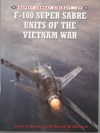 Developed from the North American F-86 Sabre, the F-100 Super Sabre entered service in 1954 and was the first Western jet fighter capable of sustained Mach 1 flight. It proved to have a goodly share of hazardous quirks, which were either remedied or were within the capabilities of pilots like Colonel Robert Wendrock, who declared, “It was fairly easy to fly, but could bite you in the rear if you did not respect it.”
Developed from the North American F-86 Sabre, the F-100 Super Sabre entered service in 1954 and was the first Western jet fighter capable of sustained Mach 1 flight. It proved to have a goodly share of hazardous quirks, which were either remedied or were within the capabilities of pilots like Colonel Robert Wendrock, who declared, “It was fairly easy to fly, but could bite you in the rear if you did not respect it.”
In 1964 the F-100 began flying combat missions, first over Laos and then Vietnam, where it would continue to serve, mostly over the South, until 1971—longer than either the Republic F-105 Thunderbolt or the McDonnell F-4 Phantom II. Peter Davies, aided by 22-year Air Force pilot David Menard and aviation artist Rolando Ugolini, presents the many roles played by the “Hun,” often unnoticed by all but the troops it supported, in F-100 Super Sabre Units of the Vietnam War, No. 89 in Osprey’s Combat Aircraft series. Armed with four 20mm cannons as well as hard points for extra fuel, rockets and bombs, the F-100C and F-100D performed a variety of ground support duties, often placing their ordnance more precisely than their newer contemporaries. For a short time they escorted F-105Ds on bombing missions to North Vietnam, and the book gives a detailed description of the dogfight on April 4, 1965, in which Captain Donald Kilgus claimed a MiG-17F that was never credited to him by the U.S. Air Force, but which was confirmed by surviving North Vietnamese Senior Lt. Tran Hanh in his combat report.
Communist anti-aircraft fire took a heavy toll on the “Huns,” whose fighter-bomber units adopted a policy of “one pass, haul ass,” but that was not possible for the two-seat F-100Fs that were spotting and identifying targets for airstrikes or artillery in “Misty” forward air control missions. Among the F-100Fs illustrated in the book is the one in which Major George Day and Captain Corwin Kippenham were brought down by 37mm fire on August 26, 1967, after which Kippenham was rescued but the injured “Bud” Day would endure torture in enemy hands until his release in March 1973, subsequently receiving the Medal of Honor. The F-100Fs were also the first to engage in low-level “Wild Weasel” attacks on surface-to-air missiles and their radar, for which later F-105Fs and F-105Gs have received more publicity. Replete with firsthand accounts of their tactical activities, F-100 Super Sabre Units of the Vietnam War sheds some belated light on an early workhorse—and warhorse—of the air war in Indochina.
Osprey Publishing, 2011




